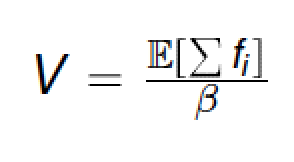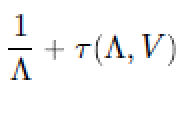Bitcoin’s Fatal Flaw:
The Limited Adoption Problem
Discussion by Katya Malinova



Franz Hinzen, Kose John, Fahad Saleh

Brief Summary
- Bitcoin (proof-of-work) blockchain is not scalable
- Limited adoption: the fraction of users who use the blockchain for payments vanishes as the number of users increases
- Permissioned blockchain is a viable alternative
- But not for all consensus mechanisms, e.g.:
- simple majority voting doesn't work
- voting scaled by crypto-currency holdings does
- But not for all consensus mechanisms, e.g.:
- Blockchain as payment infrastructure

Model (PoW): Users
N users need to transact & choose:
Blockchain:
"Traditional" payment system
- unmodelled
- normalized as zero reward, zero cost?

Reward (from using blockchain?)
Fee to miners
Waiting cost:
"user impatience \(c_i\)" \(\times\) "time to confirm"

Model (PoW): Validators
- Assumed to coordinate on the longest chain, no malicious behavior
Cost of validation technology
Number of validators

Sum of user fees
- Free entry:

Model (PoW): Equilibrium
- Low enough impatience \(c_i\le c^* \Rightarrow \) use blockchain
- Marginal user \(c^*\) pays the highest fee and waits for:

block's arrival rate
fork/dispute resolution time
\(\infty\)
as \(N\to\infty\)
\(c^* \to 0\)
"limited adoption"

Comments/Questions:

\(\infty\)
Key Result:
- as \(N\to\infty\), the number of validators \(V\to \infty\)
- Why do forks take \(\infty\) to resolve?
Network delay/physical system limits
- \(\to \) with \(V=\infty\), time to agree/communicate explodes
Lemma B.1 in Appendix B ....

Comments/Questions:
Number of validators V determined by free entry:

Number of users \(N \to \infty \)
- \(\Rightarrow\) expected fees \(\to \infty\)
Comment 1: need more intuition for this:
- User i pays fee \(f_i \propto (N-1) c_i^2\)
- With \(N\to\infty\), wait times explode & only super-patient users use blockchain ....
- \(\to \) \(c_i \approx 0 \)
- Fraction of blockchain users vanishes ...
- What happens to fee per user?

Comments/Questions:
Number of validators V determined by free entry:

Number of users \(N \to \infty \)
- \(\Rightarrow\) expected fees \(\to \infty\)
Comment 2:
- Confirmation times \(\to \infty\)
\(\Rightarrow\) fees are received with infinite delay - Technology costs are incurred in real time!(?)
- Are validators infinitely patient? No capital constraints?
- Is there a transversality condition?

Model 2: (Permissioned Blockchain)
Validators:
- Finite number
- Play a coordination game, choose:
- be malicious
- exogenous reward & cost
- be honest
- be malicious
Users:
- same as before
- Where does the reward come from?
- Seemingly should depend on the value of transactions and/or malicious users?

Suggestion: One Paper, One Model
This paper: 2.5 models
- Proof-of-Work -- validators' incentives unmodelled
- Permissioned -- coordination game among validators
- with majority voting
- with crypto-currency stake-weighted voting
- \(\to\) must introduce and value cryptocurrency
No clear connection between #1 and #2
- Why move from decentralized proof-of-work to permissioned?
- Are there decentralized alternatives?
- E.g., require minimum crypto-stake to become a validator?

Question: purpose of a blockchain in the model?
Users obtain a reward from transacting on the blockchain:
- similar reward structure for permissionless PoW vs. permissioned
Where does the utility gain from blockchain use stem from?
- E.g., with bitcoin: censorship-resistance, immutability ...
- But this disappears if blockchain is permissioned
Key differences (from the user perspective) b/n the permissioned blockchain vs. traditional payment system in the model?
- Central Bank Digital Currency?

Suggestion: better connections to existing literature
Various "impossibility triangles" have been discussed:
- The authors mention Buterin's: scalability, security, decentralization triangle
- This is also discussed in the academic literature, e.g.:
- comp sci: Gilbert and Lynch (2002)
- econ&finance: Abadi and Brunermeier (2018)
- see Chen, Cong, Xiao (2019) for a survey

- The paper:
- co-existence of payment and currency systems
- role for the value of cryptocurrency (for the voting weights)
- users don't directly affect crypto-valuation
- Is this approach consistent with the predictions from the user-driven cryptocurrency valuation models, where value is affected by e.g.:
- possible speculation
- coordination among users
- see Malinova (2019) for a survey
Suggestion: better connections to existing literature
@katyamalinova
malinovk@mcmaster.ca

slides.com/kmalinova
https://sites.google.com/site/katyamalinova/